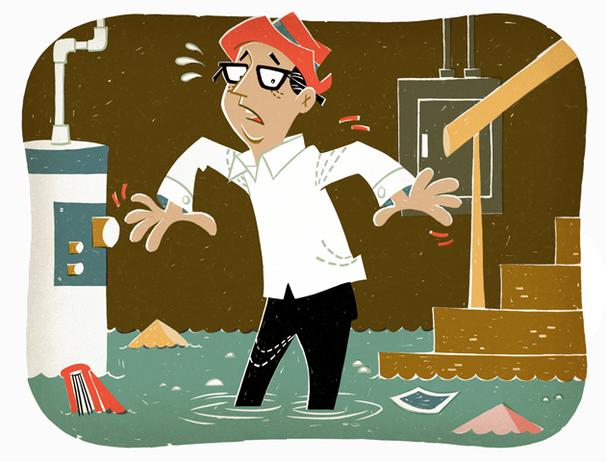 I don’t know if you’re like me, but when I came home from work last night, I had 2” of water in my basement even with the sump pump going full swing. A wet basement causes more damage than you think it might as it’s a haven for mold and can ruin carpeting, drywall, and framing. Flooding can also cause hardwood floors to buckle on the next level above the basement. Mold is a very scary thing and drying out your basement should be your #1 priority.
I don’t know if you’re like me, but when I came home from work last night, I had 2” of water in my basement even with the sump pump going full swing. A wet basement causes more damage than you think it might as it’s a haven for mold and can ruin carpeting, drywall, and framing. Flooding can also cause hardwood floors to buckle on the next level above the basement. Mold is a very scary thing and drying out your basement should be your #1 priority.
Ok…this is what you need to do to dry our your wet basement!
Whether your problem is due to incoming rain or rising groundwater, water accumulates around your foundation. Then, it works its way inside through cracks and porous material.
Thankfully, you can solve most wet-basement problems yourself and the key is to know which type of problem you have: Condensation, Runoff, or Subsurface Seepage.
Condensation
To determine if your water is from condensation, when warm air hits the cool foundation, follow this step: Tape foil over damp spots and check it after a day and if the moisture forms on the outer foil surface it is condensing from the air. If it’s on the inside, it’s seeping in from the outside. And if moisture forms on the outer foil face, water is condensing from the air. If moisture forms on the foil underside, water is seeping in from outside.
What To Do:
- Start simple by airing out the basement by opening the bulk head door, windows and run some fans. We also run our dehumidifier daily near our sump pump for easy drainage. We picked up a heavy duty one at Sears for around $200.
- If it’s too cold outside, turn up the heat in your basement. Also, make sure your dryer vents to the outside. Unless you want to increase moisture, don’t dry clothes on a rack down there. A big no-no! Plus they will have that wet dog smell…gross!
- If you’re still seeing moisture after trying these ideas, then you’re probably not dealing with condensation.
Runoff
This is what pretty much everyone is dealing with right now. Rainwater that isn’t routed away from the house is the most common cause of your flooding. Runoff happens when water percolates through porous topsoil and seeps inside cracks in basement walls. How to diagnose it you ask? This one is pretty obvious…do you have a running river in your basement like me after this recent storm?
What To Do:
- Look for ways run off water is entering into your basement inside and from the outside. Studies say to check the ground from your house at least 1 inch vertically for every 1 foot of horizontal travel.
- Then this is key…make sure your downspouts are not pooling near the foundation of the house and that they are not leaking. Make sure when you get your gutters installed that they install them with seams-out as it makes this simple check fast and easy. The less time you are out in a Nor’easter with cute red rain boots or not, the better right? Need to learn more about a proper gutter install, contact us about gutter installation.
- Next, check your driveway to make sure the water runoff is going into the street and not pooling up in your yard or back into the foundation. If you’re like us and have a gently sloping hilly area behind your house, you can install a small shallow trench with gently sloping sides and a gravel bed to catch the runoff so that it channels water past your home or to other drainage systems.
- It is also a good idea to patch up cracks in the foundation and seal your basement walls using a polyurethane masonry caulk like Sikaflex ($7 per tube).
- The key is to address the entry points outside as well by checking the driveway using a cold-mix asphalt patching compound.
- Clean your gutters so that they don’t over flow. If your home doesn’t have them, please contact us for your FREE estimate on gutters. Make sure you have downspout extensions so gutters can drain 4’ away from the house onto splash blocks. While you’re up there, please check for asphalt granules as this is a sign of roof decay. Here is a checklist to make sure your roof is ready for winter.
Subsurface Sources
If your runoff occurs all the time, you’re probably dealing with a high groundwater issue. Typically after a storm the runoff goes away but if your basement is consistently wet even after a storm you probably have a subsurface water problem.
What To Do:
This time I would suggest calling a pro as they may come up with some suggestions of combining the sump pump with perimeter drains. If you’re considering the high cost of continued subsurface water, doing it right is crucial. These are the questions you need to ask:
1. I have a pump. Why bother hiring you? A flood-control contractor salvages your stuff, protects your house’s structure should dry out the entire structure, not just the basement.
2. When the water’s pouring in, what should I do? Start pumping it out with my suggestions above but if the water reaches your electrical outlets, turn off the basement electricity and plug in the pump elsewhere. Most likely they will need to have the electric company shut off the power before they can start cleaning up.
3. I know mold is toxic, but isn’t the anti-mold treatment poisonous, too? Ask for ingredient lists for their treatments.
4. Any tips to prevent Lake Basement? They will most likely say a combo of a sump pump and French drains installed.
5. Where should I store things I want to save? They should tell you to NOT store your items in the attic or basement.
Make sure you don’t get burned and hire an insured contractor and always get a firm quote with detailed specifications like we always give. Nothing is worse than hiring a contractor to do the work only to find out it will cost thousands more. Get detailed specifications. Also get some references and ask if they would use them again and if they solved the problem.
I hope these tips were helpful for you in determining which type of flooding you have and what solutions you can use to dry out your home.
Once the storm subsides and you have done all you can, make sure there is no mold as sometimes you can’t eradicate water in places you didn’t even realize water had seeped.
Hope you stay dry and warm this winter. As always, you can reach us here with any questions on gutters, windows, and roofing as sometimes they are the cause to this flooding.
Coastal Windows & Exteriors is located in Beverly, Massachusetts and services the entire Boston area and all across Massachusetts, New Hampshire, Maine and Rhode Island. We are the #1 gutter, roofing, windows and siding contractor in Massachusetts, New Hampshire, Maine and Rhode Island.




